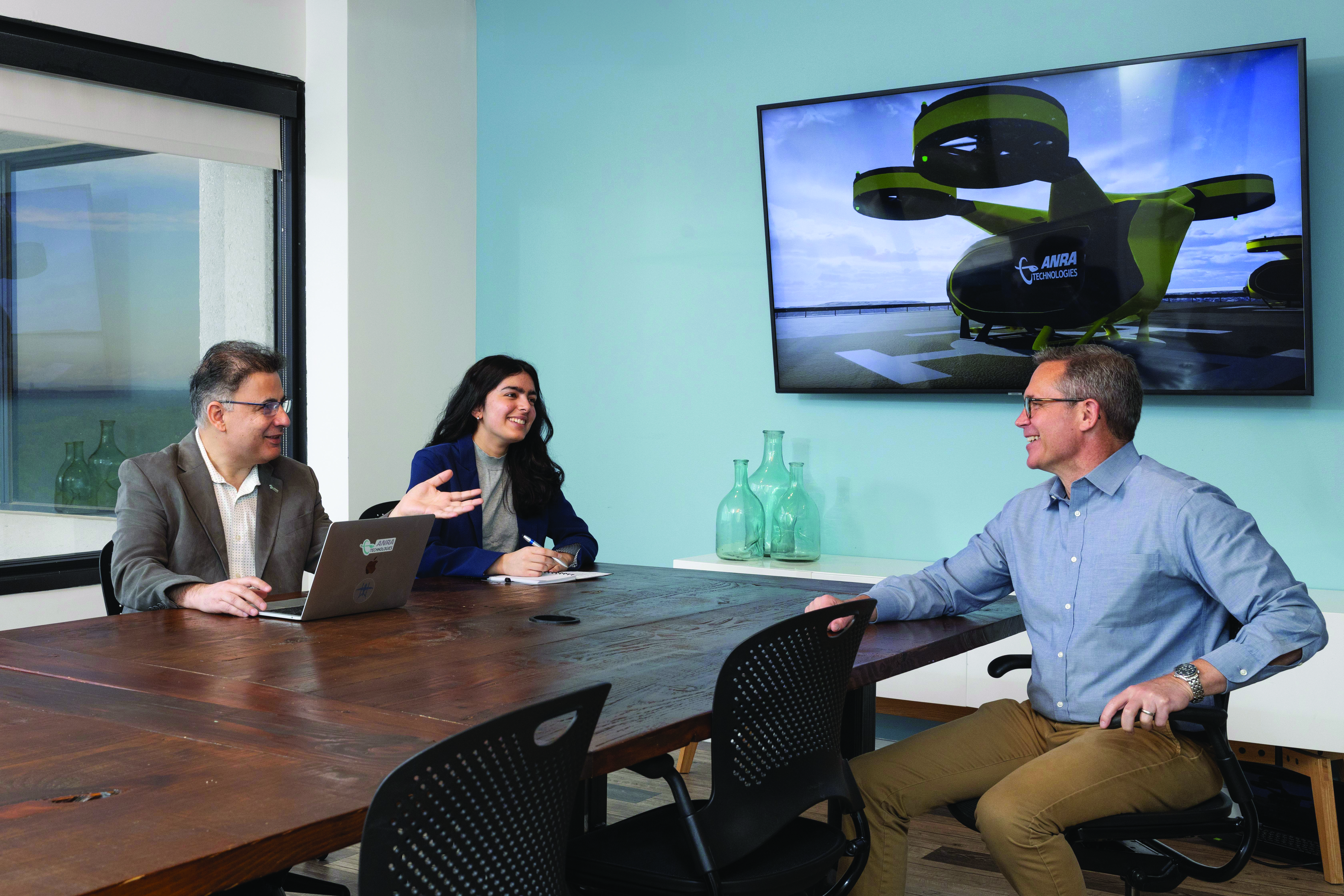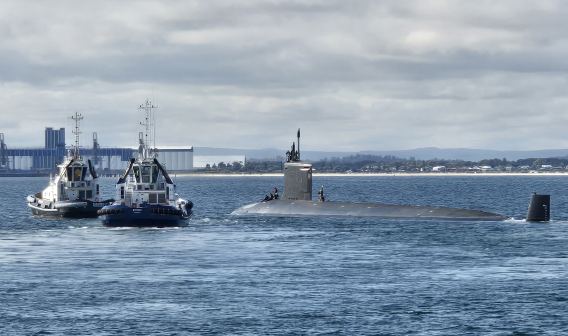Organizing the Skies
Fairfax-based ANRA Technologies works to create order from unmanned chaos, with an assist from VEDP’s VALET program
Sixty years after The Jetsons promised a future of personal-sized spacecraft that moved people and things safely through crowded skies, that vision, or something like it, is ever closer — thanks to a Virginia company that’s a global leader in building digital air highways.
ANRA Technologies, based in Reston in Fairfax County, got its start in 2015, but the history of drones dates back to the 1930s, when militaries used them to train antiaircraft gunners. Drones later took the form of remote-controlled planes that hobbyists flew for fun. Their potential took off with the development of GPS and the rise of smartphones.
“The smartphone really allowed us to move forward with technology to understand geolocation,” said Brent Klavon, head of global operations for ANRA, which also has offices in India, Estonia, and the United Kingdom.
The promise of drones has left many abuzz with the idea they’d become commonplace to deliver everything from meals to medicine. But for that promise to be realized, companies like ANRA are creating the equivalent of air traffic control so drones can be used safely.
“How do we keep our skies safe? How do we manage [drones] in a way that allows [companies] to continue to innovate and be used for industry, but at the same time make sure no one bumps into each other or does any harm?” are questions Klavon says need answers.
Moving Beyond the Line of Sight
The task is monumental, especially when compared to the safety net for commercial aviation. The high cost of planes and their operations limit how many can fly. The Federal Aviation Administration (FAA) estimates 5,400 aircraft are in the skies at peak times. The FAA tracks those flights using 520 airport traffic control towers and 14,000 air traffic controllers in the United States.
But the same air traffic system isn’t suited for the 782,203 drones registered with the FAA, a number that will increase exponentially as their commercial use expands. Those 520 airport traffic control towers aren’t equipped to help drones safely navigate low altitudes in urban and suburban spaces where the potential for commercial use is highest.
That concern has caused most of the world, including the United States, to forbid the flying of drones that are more than 55 pounds or beyond operators’ visual line of sight — a 1,000–2,000-foot leash even on clear days. While the FAA can issue waivers, companies must first provide convincing evidence they use technology that enables them to operate drones safely beyond the line of sight.
Those limits are soon to change. The FAA is creating rules that would allow drones to fly beyond the line of sight, and they’re expected to be finalized within 16 months. New rules will clear the way for companies to invest in drones and their applications, allowing that industry to take off. “You need stability in order for investment to occur,” Klavon said.
Founded in 2015 by Amit Ganjoo, who previously did work for the U.S. Department of Defense on its drone programs, ANRA partnered with NASA to figure out how unpiloted drones could replicate the safety of manned planes. Less than a decade later, ANRA is demonstrating how its airspace management can safely guide multiple companies at once. Previously, the FAA approved systems for individual companies’ own operations, ones that didn’t need to consider other companies’ airspace use.
Just like building public highways required rules that grew their use and spurred development, so will the building of what Klavon calls “digital highways.”
“We’re hopeful the FAA sees what we’re doing, takes the lessons learned — what not to do, what to do — and takes that into the next rule,” he said.

ANRA Technologies, Fairfax County
Testing International Markets
ANRA has tapped into VEDP’s International Trade offerings to build a future that extends beyond the Commonwealth, with notable successes already. In January 2023, ANRA was one of two companies selected by the European Union Aviation Safety Agency to seek certification to operate. While the other company selected, Google’s Wing subsidiary, plans to use its system only for its own drones, ANRA plans to open its service to the broader market.
“That puts us on track to be the world’s first certified airspace provider by a noted regulatory body,” Klavon said.
Meanwhile, the company has launched a demonstration program in Estonia and has been awarded a contract in Canada to provide traffic management for drones in Nova Scotia.
Navigating those factors for ANRA is a CEO who knows how to succeed in markets where rules must change to keep up with changing technology. Amit Ganjoo previously played a senior role at Swedish telecommunications giant Ericsson when the company needed to grow mobile service at a time when different countries had adopted wildly varied standards. That experience led him to push for harmonized regulations that enable drones to cross borders and operate effectively and safely.
While many of ANRA’s demonstration programs are focused on safely moving cargo at low altitudes of 400 to 500 feet, ANRA is also developing a system to manage larger drones powered by electric motors to move passengers and larger cargo loads in urban areas as far as 120 miles, all without a pilot, and at altitudes above 500 feet — requiring traffic management that considers not only drones, but planes, from private to big commercial passenger jets.
Since the drones take off and land vertically, ANRA calls the space its systems manage a Vertiport. Early planning is already underway in Los Angeles with a subsidiary of Hyundai Motor Group, Supernal, to demonstrate routes there in time for the 2028 Summer Olympics.
Such technology might someday connect Richmond with Washington. The idea is to replace gas-guzzling, polluting, noisy helicopters with quiet, clean drones.
“We’re one of the few companies in the world that does both the low altitude and urban air mobility for airspace management. We’re hopeful to continue to grow that market in Virginia,” Klavon said.
‘Punching Above Our Weight’
VEDP has also used its strong relationships with key figures overseas to help ANRA open doors to officials who could make things happen. From 2022 to early 2024, ANRA participated in VEDP’s Virginia Leaders in Export Trade (VALET) program. That funding enabled the company to show its capabilities at international trade shows, and helped develop marketing materials to share the potential of its forward-thinking air traffic management. That led to pitches in the United Kingdom, Europe, and the United Arab Emirates, where the Dubai Air Show opened paths to potential partners.
“These shows are opportunities to make business connections and develop interest, so they want to have discussions about making use of your services and technologies,” Klavon said. “VEDP has helped us punch above our weight. It allows us to expand our market reach in areas that I don’t think we would otherwise have gone into.”
VEDP has helped us punch above our weight. It allows us to expand our market reach in areas that I don’t think we would otherwise have gone into.
Along with the VALET program, the company was also able to tap into funding from VEDP’s regional export program and the State Trade Expansion Program (STEP), funded through a Cooperative Agreement with the U.S. Small Business Administration. “Those programs allowed us to expand our reach and market penetration. And in a novel industry with novel technologies, you need to be able to reach out and touch the prospective client, customer, regulator, and government official in many different markets to be able to sell,” Klavon said.
While several VEDP programs helped ANRA extend its reach globally, the Mid-Atlantic Aviation Partnership at Virginia Tech helped further its technology and collaboration with NASA and the FAA.
“They have a very strong technical background to be able to help with some very complex projects — everything from generating data for the research efforts with NASA and the FAA to co-developing technology for companies like ours,” Klavon said.
Collaboration, hard work, and ingenuity have left ANRA on the cusp of something monumental, Ganjoo said. Potential partners who were skeptics a year ago are now excited about the path ahead.
“I don’t think anyone else can claim to be in the position we are in, having gone through all these iterations since 2015, and we have the battle scars to prove it,” Ganjoo said. “We have positioned ourselves from a technical and strategic point of view, from a regulatory point of view, in the right place.”
ANRA’s success at home and abroad makes it a magnet for other businesses to come to Virginia, Ganjoo said. “Other players can come in and integrate, and we can build the whole ecosystem together. I think there’s an opportunity for us as the Commonwealth of Virginia to do a lot.”




